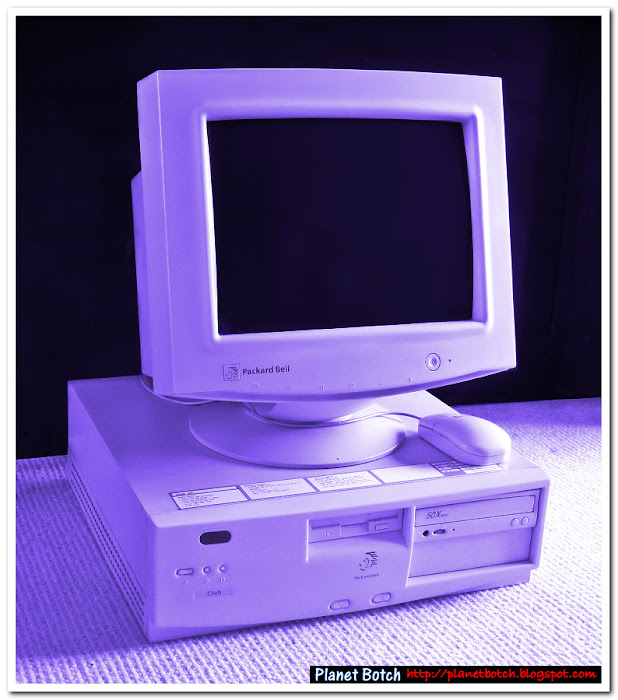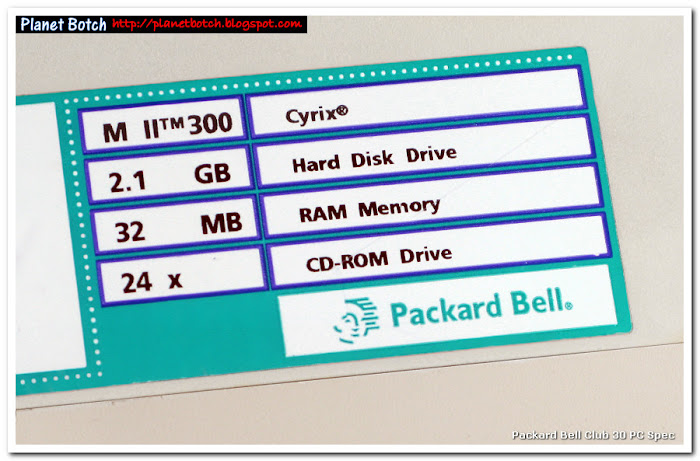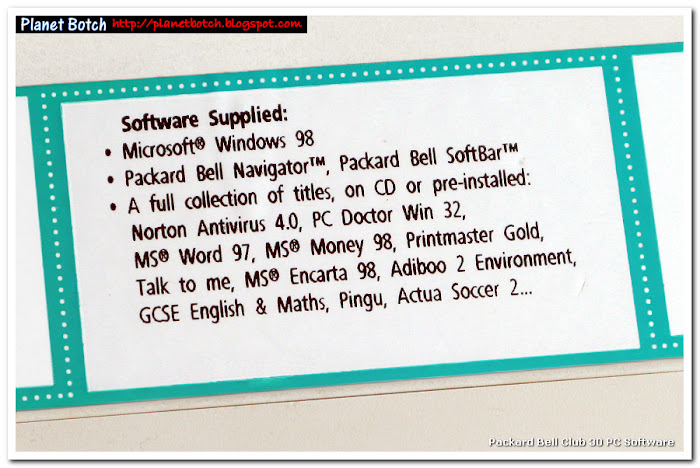
The Packard Bell Club 30 as it looked with its original base unit casing and original monitor. After the motherboard failed, I rebuilt the computer in an ATX tower case (not pictured). Only the hard drive, the CPU and the monitor remained from the original Packard Bell system after the rebuild.
That was the thing with Packard Bell. Their systems could entice people who had no particular intention of buying a new computer. On the retailer’s display, the systems looked almost too good to be true. In 1998, you’d expect a PC with a 300 MHz processor, 32 MB of RAM, and a pretty extensive suite of full-licence software to cost more than £500, and the overall package did kind of leap out at you as extremely generous for the money. Packard Bell knew that the average consumer didn’t care about or even understand the component breakdown in a system, and that what they really wanted, was applications. Listing a wide array of useful software packages to the typical PC World shopper would hold a lot more sway than trying to hook them in on a brand of hard drive or a RAM capacity, so that was precisely how Packard Bell played it.
The commercial draw of these systems, then, was very powerful. They promised a hell of a lot for what looked like a true bargain price. But as is almost invariably the case when something looks almost too good to be true, things weren’t quite what they seemed…
THE CYRIX MII 300
The processor used in the Club 30 – a Cyrix MII 300 – wasn’t actually a 300 MHz CPU. It was a 233 MHz CPU which was deemed to emulate the performance of a 300 MHz Pentium. The picture was quite confusing. The Cyrix MII 300 fitted into an older Pentium 1 MMX motherboard socket (Socket 7), but was rated in keeping with a Pentium II. And whilst it was fairly clear the Cyrix 300 was generally faster than a 233 MHz Pentium MMX, there were technical drawbacks which made it a more erratic choice for the cheap PCs it was often employed in. What you definitely weren’t getting, was the predictability of a 300 MHz Intel Pentium II. But that was only the tip of the iceberg…

The spec was clearly denoted on the top of the Club 30 base unit's case, so that shoppers would see it when browsing at PC World.
THE PROBLEMS
There were two overbearing problems with Packard Bell computers in the mid to late 1990s: 1) they were exceptionally unreliable and sometimes evidently shoddy internally, and 2) all the ‘cards’ were integrated into the motherboard circuit, rather than being installed in separate PCI or ISA slots. So if the graphics chip went down, or the sound chip went down, or whatever else, you’d need to replace the entire motherboard. Worse still, because of the outlets through which Packard Bell systems were sold (superstores and chain stores with truly grim customer service policies based almost entirely around premium rate helplines and/or paid warranty/repair setups), it would frequently be uneconomical if not impossible for the user to replace the motherboard like for like. Therefore, one chip failure in a Packard Bell PC would often mean the computer was a write-off.
Indeed, my Club 30 failed in exactly this fashion – just out of basic warranty. I tried to get a replacement motherboard and couldn’t. PC World didn't say word for word: "If you haven't bought a warranty we literally couldn't care less about this", but that was their general message, so my only option was to find a third party motherboard compatible with the Socket 7 CPU. Initially, I just wrote off the Club 30 and used a completely new computer. In time, however, when I found a cheap Socket 7 motherboard, I decided to re-compose the old system. But because the replacement Socket 7 motherboard wasn’t going to fit the Packard Bell base unit, I also needed a completely new case, soundcard, graphics card, etc. In the end, other than the CPU, the hard drive and the monitor, the rebuilt system had nothing to do with Packard Bell. I did the rebuild in the year 2000, and funnily enough that system is still going strong. I wonder if an authorised Packard Bell repair would have lasted that long?… I doubt it somehow.
PERFORMANCE AND VALUE
The thing with these old Packard Bells was that provided nothing went wrong, they were very good intrinsic value. In its day the Club 30 was pretty fast, with headroom in the resources, and the supplied software was an attractive package indeed. Windows 98 (first version, not SE) was still in its infancy, and its design and capabilities were still wowing users across the globe. Add to that the likes of Microsoft Word, Microsoft Money, Printmaster Gold, Microsoft Encarta, Actua Soccer, Norton Antivirus and PC Doctor, plus a number of educational utilities, and you had what many could regard as a complete home solution, all for one price. The programs were extremely well cherry picked, and they all had lifetime licences – not the 30/60 day nonsense which became trendy on various brands of system later on.

The raft of software included with the Packard Bell Club 30 was also proudly emblazoned onto the top of the casing. In Windows 98's year of release that lot was pretty near irresistible pre-loaded onto a £499 PC with decent hardware resources.
I can remember that Christmas of 1998 particularly well, because getting this computer made a landmark improvement to my life. Most people who remember PCs in the 1990s will confirm that there was a single point in time where the computer ceased being “just a computer”, and suddenly opened up a new world for them. A world which subordinated their social life, and became their number one leisure priority. Buying the Club 30 PC represented that moment for me. So there’s no question that this was a dynamite purchase in its day.
The snag, of course, was that when something actually did go wrong, you’d become so dependent on the machine that you couldn’t do without it. It wasn’t like, “Oh, the PC’s failed. I’ll have to think about sorting that out” – if you couldn’t get it back into action immediately, it was a major crisis. It was inevitable that, provided you had the financial means, you’d have a working computer of comparable or better spec in front of you by the following day.
CONCLUSION
You had to balance the obvious joy of using these systems against the unusually high incidence of failure on 1990s Packard Bell PCs when calculating their real terms value. And in particular, you had to take into account their integrated circuit design, along with the unavailability of component replacements. You could of course buy the warranties which protected you against hardware failures at the point of sale, but they weren't everlasting, and in any case, then you were pushing up the price of the system pretty dramatically, to the point where you could easily go elsewhere and find a more reliable and reparable PC with similar spec. Short of that, a Packard Bell Club 30 was a big gamble. But it was a big gamble you may not have realised you were taking until it was too late.
I've looked at an earlier Packard Bell PC in my 80486 MIDI Setup article.

